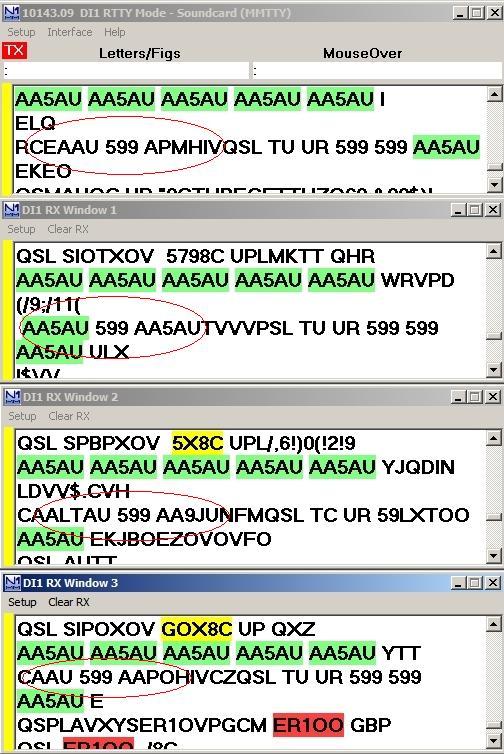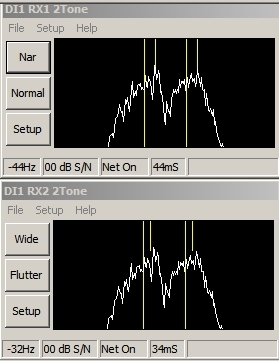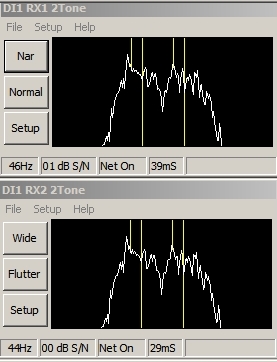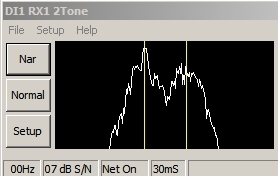2Tone vs. MMTTY - AA5AU QSO with 5X8C 2/16/2013
After spending several hours (nearly all day actually) listening to 5X8C on both 20 and 30 meter RTTY and comparing the 2Tone decoder by David, G3YYD against MMTTY, I decided to call them on 30 meters. I made the contact at 2355Z after calling only twice. They were transmitting on 10143.1 kHz and I was split up 2 kHz.
I was using an Icom IC-756 PRO III transceiver transmitting 100 watts output to an 80 meter inverted vee at 40' using the internal antenna tuner in the radio. I was receiving on a Pixel loop antenna at about 36'. Twin Peak Tuning in the PRO III was turned off and I was using the 400 Hz IF RTTY filter. AGC was set to SLOW. Their signal was S-zero with fades. My report is circled in red in all four RTTY screens. I got a QSL from the 3rd window (2Tone Normal/Wide setting) which was good enough for me to know I made the log.
The top screen is MMTTY using the Fluttered FIR profile with AGC on. The 2nd screen is 2Tone using the Normal/Narrow settings. The 3rd screen is 2Tone using the Normal/Wide settings. The last screen is MMTTY using the Standard profile with AGC on.

The above screenshots are typical of the 170 screenshots I took this day. 2Tone with the Normal/Narrow setting is best overall under all conditions (2nd screen above with the perfect print).
In DXing, I would have known it was me he was calling in any of the screens above. Been there, done that hundreds of times. But the importance here is that I actually got to see a clean report in the 2nd screen (DI1 RX Window 1) which was using 2Tone in the Normal/Narrow mode. This is more important in contesting when you need to get the exchange correct. This 2Tone Normal/Narrow mode has been consistently better, not only in the hours of decoding 5X8C this day, but also during the CQ WPX Contest the previously weekend. Regardless of whether or not it's DXing or Contesting, 2Tone is better than MMTTY when signal levels are S3 or lower. With signals S3 or greater, 2Tone is only slightly better.
Here are some conclusions made based on my decodes of 5X8C on 2/16/2013:
These observations are with no QRM present on frequency.
Very Weak signal, barely audible (30 meters) - TPF enabled on radio with SLOW or MID AGC is better because I couldn't even hear the signal without it. 300 Hz filter seems best because signal lower in audio when filter opened more regardless of turning up the soundcard level or audio level on the radio (getting audio out of the PHONES jack so I can adjust it on the radio). Get only bits and pieces of real print in 2Tone windows (Normal/Narrow better over Normal/Wide - did not use Fluttered option). Absolutely no print in MMTTY windows.
Weak signal but more audible than Very Weak Signal (30 meters) - S-meter is zero, but signal is decoding best with 2Tone Normal/Narrow with TPF enabled, SLOW or MID AGC and filter at 300 Hz. Only bits and pieces in MMTTY windows (using Flutter FIR and Normal profiles with AGC on).
Weak signal but moves the S-meter at times (30 meters)- 2Tone Normal/Narrow better. Best copy with TPF turned off on radio and using 400 Hz filter. No difference with AGC MID or SLOW. FAST AGC is worse. This is when I made my contact. Not a lot of difference with TPF enabled but I could tell it was better with it off - barely.
Weak signal peaking S3 but mostly S0 (20 and 30 meters) - 2Tone better but MMTTY gets good print too. Best copy with TPF turned off with 500 hz filter although 400 Hz filter about the same (this was on 30 meters). This is a little better than on 20 meters with 250 Hz filter in and TPF enabled in the radio.
Moderate signal at S3 with rapid QSB (20 meters) - About the same with TPF enabled or not. Used only 250 hz filter on 20 meters when signal was at this level. Signal on 30 meters was never this high. 2Tone with Normal/Narrow, AGC MID/SLOW best under these conditions. MMTTY as good about half the time. (Note that MMTTY also is better using MID/SLOW AGC as compared to FAST AGC). Note to self: Do a similar test using my Kenwood TS-870 with AGC turned OFF (as Chen suggests). This may help on signals less than S3.
Strong signal at S9 with slow QSB - 2Tone slightly better. MMTTY rarely better. Used only 250 Hz filter on 20 meters when they were S9 with only slow fading down to S3. AGC setting at MID on PRO III. I made an observation of 100 consecutive 5X8C transmissions on 20 meters when their signal was S9 using the 4 windows above and noted four conditions: When 2Tone was perfect in both windows and MMTTY wasn't in one or the other window, when MMTTY was perfect in both windows and 2Tone wasn't in one or both windows, when both 2Tone and MMTTY windows (all four windows) were perfect, and when neither was perfect. Here are the results.
2Tone Perfect, MMTTY not: 21 times (21%)
MMTTY Perfect, 2Tone not: 2 times (2%)
Both 2Tone & MMTTY Perfect: 65 times (65%)
Neither Perfect: 12 times (12%)
I don't claim these results are scientific. They don't have to be. They are enough to convince me that 2Tone is better than MMTTY nearly all the time. The best decoder is 2Tone with a Normal/Narrow setting. 2Tone with Normal/Wide is 2nd best. MMTTY fluttered FIR and MMTTY standard are about the same. The best combination for me in contesting should be both 2Tone windows and the MMTTY fluttered FIR window so I can use the tuning indicators.
Note: The tuning indicator with 2Tone is actually very good and similar to the one that WriteLog uses with it's native WinRTTY soundcard decoder. I always preferred this tuning indicator over both the FFT and XY Scope in MMTTY. With 2Tone, AFC is always on, but it's possible to use it S&P because you can line up the signal with the Mark and Space lines on the decoder. Here is what the display looks like.

This shows the 2Tone display of the Narrow/Normal and Wide/Flutter profiles with
the signal 50 Hz high on 5X8C on 30 meters. TPF enabled with 500 Hz filter.
Notice in the 2nd display the decoder did not quite make it out to the signal.
I'm wondering if this is why Narrow/Normal is better than Wide/Flutter. Just an
observation. Can't really read a lot into it other than to say the signal was
there for a few seconds before I snapped it.

This shows the same 2Tone displays with the signal 50 Hz low on 5X8C on 30
meters. TPF enabled with 500 Hz filter. Notice the displays are identical.

This shows the 2Tone display with signal on frequency. When I snapped this shot,
you will notice the Mark tone was being received. Notice that when the signal is
tuned in properly, the two lines appear as one. TPF enabled with 250 Hz filter.
I don't think there's any need for more testing. It's clear to me. I hope it's clear to you. 2Tone is just better! Congrats to David, G3YYD, for an excellent soundcard decoder. Just need to get it incorporated into WriteLog and I'm all set! Using two instances of 2Tone and one instance of MMTTY appears to be the correct combination.
73, Don AA5AU